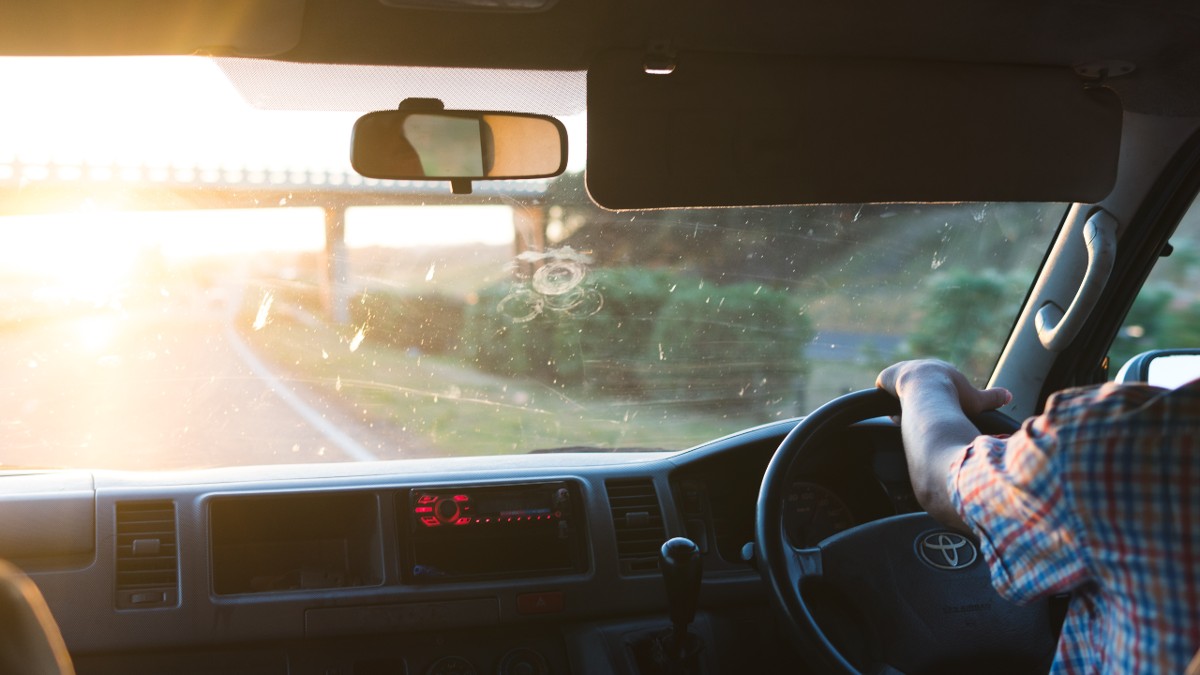A glare that may happen during the day or at night isn’t something you would want on your windshield. It obstructs vision and causes temporary blindness with accidents in worse-case scenarios. Perhaps you’re now wondering how to prevent glare on your windshield.
When you find yourself driving towards a rising sun, it’s a sign of glare at night or during the day, risking yourself, your passengers, and other road users. Put anti-glare coating, anti-glare film, anti-reflective coating, vinegar, or tint the windshield to avoid glare.
What Causes Glare?
Glare is a visual sensation resulting from extreme and uncontrolled brightness. The glare effect is a white area appearing self-luminous when linearly decreasing luminance ramps surround it. Glare on the windshield affects the field of vision and slows response time, putting you at risk.
Dealing with glare during the day and at night is different since it results from entirely different issues. The most important part is to have visibility to navigate safely to your destination. Day glare comes from a higher angle, while that at night is from someone driving with a high beam.
What Can I Put On The Windshield To Avoid Glare?
Windshield glare is bothersome and poses a danger to the driver and other road users since it encourages accidents. Drivers must see ahead while on the road. Glare results from sunlight or headlight beams from oncoming cars.
Here are some things to put on your windshield to avoid glare.
Anti-Glare Glass Cleaner
Streaks and deposits on your windshield reduce visibility and may cause dangerous sun dazzle. A quality glass cleaner will guarantee good visibility with a streak-free finish. This will guarantee that you have a clear view of the road ahead.
A quality glass cleaner removes insect deposits, traffic, and tobacco film. An advanced glass cleaner eliminated glare at night. You can use it for interior, and exterior glass, mirrors, and other glass surfaces.
Anti-Glare Film
Excessive and uncontrolled bright light makes visibility hard. Exposure may make you end up with problems like migraines, eye strain, and general comfort. Older people are at a higher risk of problems resulting from glare.
Using anti-glare film is an excellent solution to glare while driving. The film protects the driver from the effects of glare and UV exposure which may damage your skin. The anti-glare coating creates a fine haze layer between your eyes and glass for better visibility.

Anti-Reflection Coating
You can also use an anti-reflective coating to avoid glare on your windshield. The best product should have a repellant coating. Its hydrophobic properties will allow better vision while driving in the rain. The anti-glare feature of the coating encourages better vision at night.
The anti-reflective coating also adds thickness to the windshield surface to make breaking hard.
Splinter protection film. The hydrophobic properties of this coating make it suitable for various applications to protect them from water.
Window Treatment Products
You can also improve driving safety by applying window treatment on your windshield. Applying this will make wiping ice, water, and bugs easier for a clear view. Glass treatment improves visibility by about 34%.
Increased visibility improves the response rate by about 25% to avoid accidents. A window treatment works by coating the windshield with a water-repellent silicone film. This makes water bead up for the blades to easily wipe the water, ice, and bugs.
Quality water treatment creates a silicone film that chemically bonds with glass to last about six months. Fortunately, you can buy the window treatment and apply it yourself. You must clean the windshield and let the glass dry before applying.
An Ice Shield
Another solution to avoid glare on your windshield is to use an ice shield. You place this transparent protective film on the glass to boost its reflective ability. The ice shield dulls all reelected light to boost visibility.
Vinegar
The windshield becomes dirty easily if you drive often. A dirty windshield doesn’t distribute light well and encourages glare. You can wash the car yourself or take it to a professional. If you choose to DIY, you can put vinegar on the windshield.
However, you don’t have to leave any post-wash streaks. This will obstruct your vision and promote glare. Cleaning your windshield at least once a week using vinegar is strongly recommended.
Tint
If you live in a sunny state, tinting your windshield will prevent glare. You must check available laws in your state before tinting your car. Some states forbid tinting, and you may be penalized if you do.
Although tinting eliminates glare from sunlight, it’s ineffective for glare from headlamps and taillights. Safety regulations limit applying tint to 15% to 20%. Quality tint lasts years and is removable if you wish.
Tinting the windshield makes it virtually shatter-proof with less possibility of breaking. A tinted windshield has additional benefits, including preventing others from peeking into your car.
A Dash Mat
A dash mat can significantly reduce and eliminate glare. A bare plastic dashboard is highly reflective. The reflected light strains the driver’s eyes and hinders visibility. The problem is worse in modern vehicles with a wider dashboard that increases the surface area for glare.
Quality dash mats are available for all car models and brands. You can choose one designed and tested to protect your car from the sun’s relentless rays. A durable dash mat will protect your windshield from irritating glare.
Other things you can do to prevent glare on your windshield include:
- Using a sun visor
- Wearing eye protection during the day
- Adjusting the rearview mirror
- Using anti-glare glasses
- Cleaning the headlights
- Taking breaks on a long trip
Conclusion
Windshield glare is bothersome and hinders visibility contributing to many road accidents. Glare may happen during the day from sunlight or at night from headlight beams. Putting things like an anti-glare coating, vinegar, tint, or reflective film will avoid glare on your windshield.

